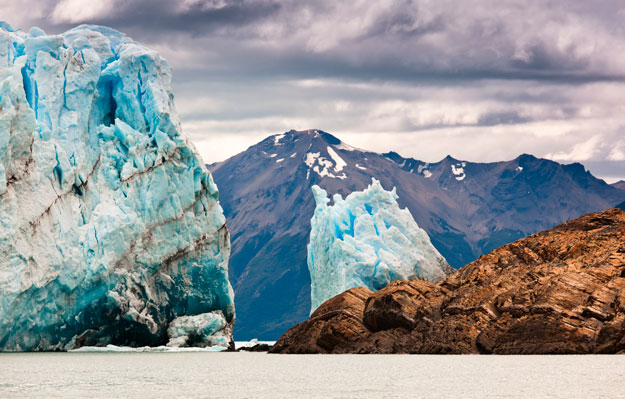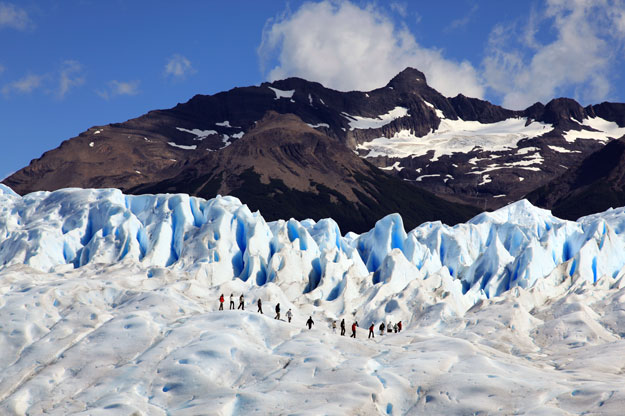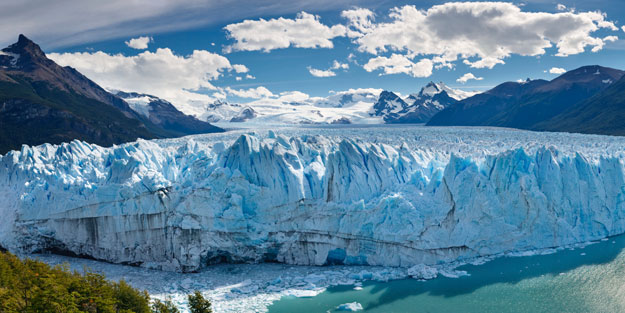Los Glaciares National Park
Kingdom of Ice
Bekah McNeel scales the imposing frozen formations of Patagonia’s Los Glaciares National Park.
As I stood on the deck of the catamaran gliding across the water in front of the Perito Moreno glacier, I put my camera down. I had already captured twenty of the most stunning snapshots my iPhone will ever hold. And we were only twenty minutes into the expedition. So I took a moment to be still in the presence of the towering wall of ice, which grew more imposing and grand as we sailed among the tiny icebergs recently calved from its terminus.
In my awe and anticipation, I am not alone. Patagonia’s windswept vistas have been inspiring the most intrepid of explorers over the last century. Peaks and lakes juxtaposed with sprawling pampas yield some of the most dramatic landscapes on the planet. They beckon the adventurer in all of us, whether it is to wander or to summit. The crown jewels of this vast and untamed region are the glaciers. From every angle they assert their mass and complexity.

As our boat neared the shelter, the place we would leave behind our food and extra clothing, the excitement began to build among the small group of trekkers. Soon we would be walking among the crags and crevasses now looming large before us. The short hike along the water’s edge reminded me of the varied beauty of Patagonia, a rich in forests and rivers as it is in the sexier landforms.
Once we reached the moraine where we would launch onto the actual glacier, our guide (who up to this point had been chatty and casual), became more serious, reminding us that we were stepping onto foreign terrain. The guides fitted us with crampons, and taught us how to walk without tangling our feet. They warned us not to get complacent, even as we felt that we were getting confident on the ice. When people get cocky and try to be funny on the glacier, they end up on their backsides, or worse. Crevasses pose a particularly sinister threat. If you fall in, each inhaled breath allows you to sink lower and lower into the crack until you are impossibly wedged. With that chilling image in mind, I resolved myself to mindfulness, and proceeded with caution. These last steps were the culmination of a long, multi-modal adventure.
El Calafate, is deep into Patagonia, near the southern tip of South America. The flights and drive times are long, and boats are usually part of the transportation plan as well. And then, for those whose dream is to stand on a glacier, the journey leaves plane, car, and boat behind until you are left with only your two feet to carry you onto the ice.

Our first steps onto the ice were electric. Initially, I could only hear the crunching of the crampons as we deliberately dug for our footing and focused on each step. As we climbed a narrow pass and became more surefooted, people began to make sounds again. Mostly “wow,” and “Oh my gosh, look!” Every turn revealed a new tableau that looked like the set of a Hollywood movie about a snow princess. The view was sprinkled with sharp séracs and glowing cerulean crevasses against the pristine white fields of ice. Glaciers are constantly moving as the top layers melt and moved forward, loud cracks and rumbles echo through the ice below. Eventually the top layer moves far enough beyond the base that ice calves off the end. While the ground beneath us felt steady, we could occasionally hear a groan or a crack like the sound of a giant bowling ball hitting Redwood-sized pins.
Later that day we would walk the catwalks facing the glacier, and witness the changes taking place as icebergs calved into the water. The preceding gunshot sounds echo across the Peninsula de Magallenes, and we would whip our heads around waiting for the ice to fall.
Now looking down over the lake from atop the very glacier I had photographed an hour earlier, I was ecstatic. The wonderment of the initial steps gave way to a sort of glee at breathing some of the most rarefied air in nature.
The trek came to tiny pond of glacial melt, and our guides encouraged us to give it a taste. Those who dared to take off their gloves and plunged their cupped hands into the icy water were richly rewarded with a drink so pure it was almost sweet.
On we twisted through the terrain, time slipping by almost without notice. Only after a shaky step over a crevasse did I realize how tired my legs had become. As we rounded what we thought would be the last turn back toward the shelters, the guides detoured us to a little u-shaped valley, where a bar cart stood awaiting our arrival. Everyone took an air-chilled tumbler while the guide chiseled some ice from the wall of the glacier. He served up a round of whiskey on the rocks, and then served alfajores, the favorite Argentinean treat. It may have been the trek, but I think it was the most delicious alfajor I ate on my entire trip.

It really is my privilege to see the glaciers of Los Glaciares National Park. These dynamic landforms are so surprisingly fragile. Thanks to the intense conservation efforts in Patagonia, Perito Moreno and some its neighbors are are some of the few glaciers in the world that are actually advancing rather than retreating. To see them is to see an endangered species, thriving in its native habitat.
After a toast and a treat, we made our way back to the shelters, and lazily drifted back to the embarkation shelter, where our lunches were waiting. Feeling more reflective than social, I found a comfortable spot on a boulder where I could look back on the glacier while I ate.
The severity and serenity of the glaciers of Los Glaciares National Park is humbling. I felt small, but peaceful and alive. If I ever get to go back to see Perito Moreno, I know that it will be different ice than what I saw on that day. The face of the glacier will look different. The séracs and glacial ponds will be in different places.
To book a journey to Argentina’s Los Glaciares National Park, contact your Ker & Downey Travel Professional. For further inspiration, follow us on Facebook, Instagram, and Twitter.
